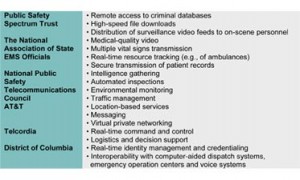National Broadband Plan Released
APCO and the public safety community have been anticipating the release of the FCC’s National Broadband Plan for some time now. In March, the FCC finally released the plan. (Download the plan here.)
Announcing the plan’s release on March 15, FCC Chairman Julius Genachowski told correspondent Jeffrey Brown of The PBS NewsHour, “We are lagging behind globally when it comes to our broadband infrastructure, our high-speed Internet infrastructure, and its adoption. Other countries have moved ahead of us.”
He continued, “Our goal is to lift adoption in this country from about 65% to over 90% in the next 10 years.”
“Broadband can bolster efforts to improve public safety and homeland security,” the plan states, “by allowing first responders to send and receive video and data, by ensuring all Americans can access emergency services and improving the way Americans are notified about emergencies.”Figure 1 [right] shows some of the possible public safety applications for a national broadband network.
To achieve these objectives, the plan makes recommendations to:
- Support deployment of a nationwide, interoperable public safety mobile broadband network,with funding of up to $6.5 billion in capital expenditures over 10 years [emphasis added], which could be reduced through cost efficiency measures and other programs. Additional funding will be required for operating expenses.
- Promote innovation in the development and deployment of next-generation 9-1-1 and emergency alert systems.
- Promote cybersecurity and critical infrastructure survivability to increase user confidence, trust and adoption of broadband communications.”
The plan includes a recommendation to “[license] the D block for commercial use, with options for public safety partnership.” Further, it includes a goal to make 500 megahertz of spectrum available for broadband within 10 years. The idea is that future wireless auctions would make the overall plan revenue neutral. The funding requests primarily relate to public safety, deployment to unserved areas and adoption efforts. “If the spectrum auction recommendations are implemented, the plan is likely to offset the potential costs,” the plan states.
“[W]ith broadband, 9-1-1 call centers (also known as public safety answering points or PSAPs) could receive text, pictures and videos from the public and relay them to first responders. Similarly, the government could use broadband networks to disseminate vital information to the public during emergencies in multiple formats and languages.”
The FCC estimates that “ongoing costs, including operating expense and appropriate network improvement costs are expected to rise from zero at the beginning of FY2011 to a peak of as much as $1.3 billion per year in year 10 of the capital build program … [and that] the total present value of the capital expenditure and ongoing costs over the next 10 years is approximately $12–16 billion.”
Genchowski said, “We will not succeed in our broadband goals if we don’t see massive investment from private sector companies. It’s why some of our core goals involve removing barriers to private sector investment, lowering the costs of investment, cutting through red tape. We need to take very seriously the fact that, in this country, our infrastructures are going to be built by private money.”
The plan suggests that state and local governments could contribute funds to cover some of these costs. And the plan states: “a grant program will be designed to provide federal support to local efforts in order to fund the capital and ongoing costs of the public safety broadband network. The grant program must provide public safety network operators with long-term support and enough flexibility to form appropriate partnerships with systems integrators and other vendors to ensure the public safety broadband network is deployed properly.”
“Congress has been asking how much it will cost to build out the public safety broadband network, and we applaud the FCC for answering this critical question.” APCO International President Richard Mirgon said. “We strongly believe that if the [National Broadband Plan] is going to be successful, then Congress must be willing to establish funding programs that take into account local, state, tribal and federal funding resources needed to build out the wireless broadband network.”
APCO is still very concerned that the plan recommends the auction of the 700 MHz D Block spectrum. “In order for any public safety broadband plan to be successful, Congress must act quickly to enact legislation that will allocate the D Block spectrum for public safety use,” APCO has stated. “Without sufficient spectrum, public safety will not be able to meet the mission critical needs of our first responders, which will place the public’s safety and the safety of our first responders at risk.”
About the Author
Keri Losavio is the editor of Public Safety Communications. Contact her via e-mail at psceditor@apcointl.org.


